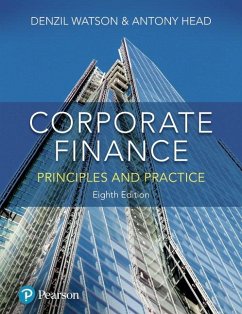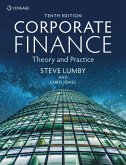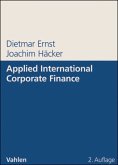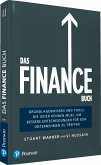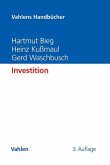- Broschiertes Buch
- Merkliste
- Auf die Merkliste
- Bewerten Bewerten
- Teilen
- Produkt teilen
- Produkterinnerung
- Produkterinnerung
Corporate Finance: Principles and Practice is the book that helps you to get to grips with core concepts and topics of corporate finance all in one short volume, illustrating applications with examples from well-known companies, and explaining the key principles and mathematical techniques needed to be successful in your studies and in your career.
MyLab Finance is not included. Students, if MyLab Finance is a recommended/mandatory component of the course, please ask your instructor for the correct ISBN and course ID. MyLab Finance should only be purchased when required by an instructor.…mehr
Andere Kunden interessierten sich auch für
![Corporate Finance Corporate Finance]() Steve LumbyCorporate Finance90,99 €
Steve LumbyCorporate Finance90,99 €![Applied International Corporate Finance Applied International Corporate Finance]() Dietmar ErnstApplied International Corporate Finance59,80 €
Dietmar ErnstApplied International Corporate Finance59,80 €![Das Finance Buch Das Finance Buch]() Stuart WarnerDas Finance Buch24,95 €
Stuart WarnerDas Finance Buch24,95 €![Investition Investition]() Hartmut BiegInvestition34,90 €
Hartmut BiegInvestition34,90 €![Finanzierung Finanzierung]() Jochen DrukarczykFinanzierung37,90 €
Jochen DrukarczykFinanzierung37,90 €![Betriebliche Finanzierung ¿ Schnell erfasst Betriebliche Finanzierung ¿ Schnell erfasst]() Udo TerstegeBetriebliche Finanzierung ¿ Schnell erfasst27,99 €
Udo TerstegeBetriebliche Finanzierung ¿ Schnell erfasst27,99 €![Unternehmensfinanzierung Unternehmensfinanzierung]() Jean-Paul ThommenUnternehmensfinanzierung27,90 €
Jean-Paul ThommenUnternehmensfinanzierung27,90 €-
-
-
Corporate Finance: Principles and Practice is the book that helps you to get to grips with core concepts and topics of corporate finance all in one short volume, illustrating applications with examples from well-known companies, and explaining the key principles and mathematical techniques needed to be successful in your studies and in your career.
MyLab Finance is not included. Students, if MyLab Finance is a recommended/mandatory component of the course, please ask your instructor for the correct ISBN and course ID. MyLab Finance should only be purchased when required by an instructor. Instructors, contact your Pearson representative for more information.
Hinweis: Dieser Artikel kann nur an eine deutsche Lieferadresse ausgeliefert werden.
MyLab Finance is not included. Students, if MyLab Finance is a recommended/mandatory component of the course, please ask your instructor for the correct ISBN and course ID. MyLab Finance should only be purchased when required by an instructor. Instructors, contact your Pearson representative for more information.
Hinweis: Dieser Artikel kann nur an eine deutsche Lieferadresse ausgeliefert werden.
Produktdetails
- Produktdetails
- Verlag: Pearson
- 8. Aufl.
- Seitenzahl: 520
- Erscheinungstermin: 5. März 2019
- Englisch
- Abmessung: 246mm x 192mm x 22mm
- Gewicht: 868g
- ISBN-13: 9781292244310
- ISBN-10: 1292244313
- Artikelnr.: 56522576
- Herstellerkennzeichnung
- Libri GmbH
- Europaallee 1
- 36244 Bad Hersfeld
- 06621 890
- Verlag: Pearson
- 8. Aufl.
- Seitenzahl: 520
- Erscheinungstermin: 5. März 2019
- Englisch
- Abmessung: 246mm x 192mm x 22mm
- Gewicht: 868g
- ISBN-13: 9781292244310
- ISBN-10: 1292244313
- Artikelnr.: 56522576
- Herstellerkennzeichnung
- Libri GmbH
- Europaallee 1
- 36244 Bad Hersfeld
- 06621 890
Denzil Watson is a Principal Lecturer, and Antony Head is an Associate Lecturer in the Sheffield Business School at Sheffield Hallam University. They both have extensive experience teaching Corporate Finance, managerial finance, and strategic financial management in a wide range of courses, at undergraduate, postgraduate, and professional levels.
Preface Acknowledgements
1. The finance function Learning objectives Introduction
o 1.1 Two key concepts in corporate finance
o 1.2 The role of the financial manager
o 1.3 Corporate objectives
o 1.4 How is shareholder wealth maximised?
o 1.5 Agency theory
o 1.6 Corporate governance
o 1.7 Conclusion
Key points Self-test questions Questions for review Questions for
discussion References Recommended reading
2. Capital markets, market efficiency and ratio analysis Learning
objectives Introduction
o 2.1 Sources of business finance
o 2.2 Capital markets
o 2.3 Capital market efficiency
o 2.4 Assessing financial performance
o 2.5 Conclusion
Key points Self-test questions Questions for review Questions for
discussion References Recommended reading
3. Short-term finance and working capital management Learning objectives
Introduction
o 3.1 The objectives of working capital management
o 3.2 Working capital policies
o 3.3 Working capital and the cash conversion cycle
o 3.4 Overtrading
o 3.5 Managing inventory
o 3.6 Managing cash
o 3.7 Managing trade receivables
o 3.8 Conclusion
Key points Self-test questions Questions for review Questions for
discussion References Recommended reading
4. Long-term finance: equity finance Learning objectives Introduction
o 4.1 Equity finance
o 4.2 The Stock Exchange
o 4.3 Rights issues
o 4.4 Scrip issues, share splits, scrip dividends and share
repurchases
o 4.5 Preference shares
o 4.6 Conclusion
Key points Self-test questions Questions for review Questions for
discussion References Recommended reading
5. Long-term finance: debt finance, hybrid finance and leasing Learning
objectives Introduction
o 5.1 Bonds, loan notes, loan stock and debentures
o 5.2 Bank and institutional debt
o 5.3 International debt finance
o 5.4 Convertible bonds
o 5.5 Warrants
o 5.6 Valuing fixed interest bonds
o 5.7 Valuing convertible bonds
o 5.8 Leasing
o 5.9 Evaluating the financial effects of financing choices
o 5.10 Conclusion
Key points Self-test questions Questions for review Questions for
discussion References Recommended reading
6. An overview of investment appraisal methods Learning objectives
Introduction
o 6.1 The payback method
o 6.2 The return on capital employed method
o 6.3 The net present value method
o 6.4 The internal rate of return method
o 6.5 Comparing the NPV and IRR methods
o 6.6 The profitability index and capital rationing
o 6.7 The discounted payback method
o 6.8 Conclusion
Key points Self-test questions Questions for review Questions for
discussion References Recommended reading
7. Investment appraisal: applications and risk Learning objectives
Introduction
o 7.1 Relevant project cash flows
o 7.2 Taxation and capital investment decisions
o 7.3 Inflation and capital investment decisions
o 7.4 Investment appraisal and risk
o 7.5 Appraisal of foreign direct investment
o 7.6 Empirical investigations of investment appraisal
o 7.7 Conclusion
Key points Self-test questions Questions for review Questions for
discussion References Recommended reading
8. Portfolio theory and the capital asset pricing model Learning
objectives Introduction
o 8.1 The measurement of risk
o 8.2 The concept of diversification
o 8.3 Investor attitudes to risk
o 8.4 Markowitz's portfolio theory
o 8.5 Introduction to the capital asset pricing model
o 8.6 Using the CAPM to value shares
o 8.7 Empirical tests of the CAPM
o 8.8 Conclusion
Key points Self-test questions Questions for review Questions for
discussion References Recommended reading
9. The cost of capital and capital structure Learning objectives
Introduction
o 9.1 Calculating the cost of individual sources of finance
o 9.2 Calculating the weighted average cost of capital
o 9.3 Average and marginal cost of capital
o 9.4 The CAPM and investment appraisal
o 9.5 Practical problems with calculating WACC
o 9.6 WACC in the real world
o 9.7 The cost of capital for foreign direct investment
o 9.8 Gearing: its measurement and significance
o 9.9 The concept of an optimal capital structure
o 9.10 The traditional approach to capital structure
o 9.11 Miller and Modigliani (I): net income approach
o 9.12 Miller and Modigliani (II): corporate tax
o 9.13 Market imperfections
o 9.14 Miller and personal taxation
o 9.15 Pecking order theory
o 9.16 Conclusion: does an optimal capital structure exist?
Key points Self-test questions Questions for review Questions for
discussion References Recommended reading
10. Dividend policy Learning objectives Introduction
o 10.1 Dividends: operational and practical issues
o 10.2 The effect of dividends on shareholder wealth
o 10.3 Dividend irrelevance
o 10.4 Dividend relevance
o 10.5 Dividend relevance or irrelevance?
o 10.6 Dividend policies
o 10.7 Alternatives to cash dividends
o 10.8 Empirical evidence on dividend policy
o 10.9 Conclusion
Key points Self-test questions Questions for review Questions for
discussion References Recommended reading
11. Mergers and takeovers Learning objectives Introduction
o 11.1 The terminology of mergers and takeovers
o 11.2 Justifications for acquisitions
o 11.3 Trends in takeover activity
o 11.4 Target company valuation
o 11.5 The financing of acquisitions
o 11.6 Strategic and tactical issues
o 11.7 Divestment
o 11.8 Private equity
o 11.9 Empirical research on acquisitions
o 11.10 Conclusion
Key points Self-test questions Questions for review Questions for
discussion References Recommended reading
12. Risk management Learning objectives Introduction
o 12.1 Interest and exchange rate risk
o 12.2 Internal risk management
o 12.3 External risk management
o 12.4 Futures contracts
o 12.5 Options
o 12.6 Swaps
o 12.7 Issues in interest and exchange risk management
o 12.8 Political risk
o 12.9 Conclusion
Key points Self-test questions Questions for review Questions for
discussion References Recommended reading
Answers to self-test questions Glossary Present value tables Index
1. The finance function Learning objectives Introduction
o 1.1 Two key concepts in corporate finance
o 1.2 The role of the financial manager
o 1.3 Corporate objectives
o 1.4 How is shareholder wealth maximised?
o 1.5 Agency theory
o 1.6 Corporate governance
o 1.7 Conclusion
Key points Self-test questions Questions for review Questions for
discussion References Recommended reading
2. Capital markets, market efficiency and ratio analysis Learning
objectives Introduction
o 2.1 Sources of business finance
o 2.2 Capital markets
o 2.3 Capital market efficiency
o 2.4 Assessing financial performance
o 2.5 Conclusion
Key points Self-test questions Questions for review Questions for
discussion References Recommended reading
3. Short-term finance and working capital management Learning objectives
Introduction
o 3.1 The objectives of working capital management
o 3.2 Working capital policies
o 3.3 Working capital and the cash conversion cycle
o 3.4 Overtrading
o 3.5 Managing inventory
o 3.6 Managing cash
o 3.7 Managing trade receivables
o 3.8 Conclusion
Key points Self-test questions Questions for review Questions for
discussion References Recommended reading
4. Long-term finance: equity finance Learning objectives Introduction
o 4.1 Equity finance
o 4.2 The Stock Exchange
o 4.3 Rights issues
o 4.4 Scrip issues, share splits, scrip dividends and share
repurchases
o 4.5 Preference shares
o 4.6 Conclusion
Key points Self-test questions Questions for review Questions for
discussion References Recommended reading
5. Long-term finance: debt finance, hybrid finance and leasing Learning
objectives Introduction
o 5.1 Bonds, loan notes, loan stock and debentures
o 5.2 Bank and institutional debt
o 5.3 International debt finance
o 5.4 Convertible bonds
o 5.5 Warrants
o 5.6 Valuing fixed interest bonds
o 5.7 Valuing convertible bonds
o 5.8 Leasing
o 5.9 Evaluating the financial effects of financing choices
o 5.10 Conclusion
Key points Self-test questions Questions for review Questions for
discussion References Recommended reading
6. An overview of investment appraisal methods Learning objectives
Introduction
o 6.1 The payback method
o 6.2 The return on capital employed method
o 6.3 The net present value method
o 6.4 The internal rate of return method
o 6.5 Comparing the NPV and IRR methods
o 6.6 The profitability index and capital rationing
o 6.7 The discounted payback method
o 6.8 Conclusion
Key points Self-test questions Questions for review Questions for
discussion References Recommended reading
7. Investment appraisal: applications and risk Learning objectives
Introduction
o 7.1 Relevant project cash flows
o 7.2 Taxation and capital investment decisions
o 7.3 Inflation and capital investment decisions
o 7.4 Investment appraisal and risk
o 7.5 Appraisal of foreign direct investment
o 7.6 Empirical investigations of investment appraisal
o 7.7 Conclusion
Key points Self-test questions Questions for review Questions for
discussion References Recommended reading
8. Portfolio theory and the capital asset pricing model Learning
objectives Introduction
o 8.1 The measurement of risk
o 8.2 The concept of diversification
o 8.3 Investor attitudes to risk
o 8.4 Markowitz's portfolio theory
o 8.5 Introduction to the capital asset pricing model
o 8.6 Using the CAPM to value shares
o 8.7 Empirical tests of the CAPM
o 8.8 Conclusion
Key points Self-test questions Questions for review Questions for
discussion References Recommended reading
9. The cost of capital and capital structure Learning objectives
Introduction
o 9.1 Calculating the cost of individual sources of finance
o 9.2 Calculating the weighted average cost of capital
o 9.3 Average and marginal cost of capital
o 9.4 The CAPM and investment appraisal
o 9.5 Practical problems with calculating WACC
o 9.6 WACC in the real world
o 9.7 The cost of capital for foreign direct investment
o 9.8 Gearing: its measurement and significance
o 9.9 The concept of an optimal capital structure
o 9.10 The traditional approach to capital structure
o 9.11 Miller and Modigliani (I): net income approach
o 9.12 Miller and Modigliani (II): corporate tax
o 9.13 Market imperfections
o 9.14 Miller and personal taxation
o 9.15 Pecking order theory
o 9.16 Conclusion: does an optimal capital structure exist?
Key points Self-test questions Questions for review Questions for
discussion References Recommended reading
10. Dividend policy Learning objectives Introduction
o 10.1 Dividends: operational and practical issues
o 10.2 The effect of dividends on shareholder wealth
o 10.3 Dividend irrelevance
o 10.4 Dividend relevance
o 10.5 Dividend relevance or irrelevance?
o 10.6 Dividend policies
o 10.7 Alternatives to cash dividends
o 10.8 Empirical evidence on dividend policy
o 10.9 Conclusion
Key points Self-test questions Questions for review Questions for
discussion References Recommended reading
11. Mergers and takeovers Learning objectives Introduction
o 11.1 The terminology of mergers and takeovers
o 11.2 Justifications for acquisitions
o 11.3 Trends in takeover activity
o 11.4 Target company valuation
o 11.5 The financing of acquisitions
o 11.6 Strategic and tactical issues
o 11.7 Divestment
o 11.8 Private equity
o 11.9 Empirical research on acquisitions
o 11.10 Conclusion
Key points Self-test questions Questions for review Questions for
discussion References Recommended reading
12. Risk management Learning objectives Introduction
o 12.1 Interest and exchange rate risk
o 12.2 Internal risk management
o 12.3 External risk management
o 12.4 Futures contracts
o 12.5 Options
o 12.6 Swaps
o 12.7 Issues in interest and exchange risk management
o 12.8 Political risk
o 12.9 Conclusion
Key points Self-test questions Questions for review Questions for
discussion References Recommended reading
Answers to self-test questions Glossary Present value tables Index
Preface Acknowledgements
1. The finance function Learning objectives Introduction
o 1.1 Two key concepts in corporate finance
o 1.2 The role of the financial manager
o 1.3 Corporate objectives
o 1.4 How is shareholder wealth maximised?
o 1.5 Agency theory
o 1.6 Corporate governance
o 1.7 Conclusion
Key points Self-test questions Questions for review Questions for
discussion References Recommended reading
2. Capital markets, market efficiency and ratio analysis Learning
objectives Introduction
o 2.1 Sources of business finance
o 2.2 Capital markets
o 2.3 Capital market efficiency
o 2.4 Assessing financial performance
o 2.5 Conclusion
Key points Self-test questions Questions for review Questions for
discussion References Recommended reading
3. Short-term finance and working capital management Learning objectives
Introduction
o 3.1 The objectives of working capital management
o 3.2 Working capital policies
o 3.3 Working capital and the cash conversion cycle
o 3.4 Overtrading
o 3.5 Managing inventory
o 3.6 Managing cash
o 3.7 Managing trade receivables
o 3.8 Conclusion
Key points Self-test questions Questions for review Questions for
discussion References Recommended reading
4. Long-term finance: equity finance Learning objectives Introduction
o 4.1 Equity finance
o 4.2 The Stock Exchange
o 4.3 Rights issues
o 4.4 Scrip issues, share splits, scrip dividends and share
repurchases
o 4.5 Preference shares
o 4.6 Conclusion
Key points Self-test questions Questions for review Questions for
discussion References Recommended reading
5. Long-term finance: debt finance, hybrid finance and leasing Learning
objectives Introduction
o 5.1 Bonds, loan notes, loan stock and debentures
o 5.2 Bank and institutional debt
o 5.3 International debt finance
o 5.4 Convertible bonds
o 5.5 Warrants
o 5.6 Valuing fixed interest bonds
o 5.7 Valuing convertible bonds
o 5.8 Leasing
o 5.9 Evaluating the financial effects of financing choices
o 5.10 Conclusion
Key points Self-test questions Questions for review Questions for
discussion References Recommended reading
6. An overview of investment appraisal methods Learning objectives
Introduction
o 6.1 The payback method
o 6.2 The return on capital employed method
o 6.3 The net present value method
o 6.4 The internal rate of return method
o 6.5 Comparing the NPV and IRR methods
o 6.6 The profitability index and capital rationing
o 6.7 The discounted payback method
o 6.8 Conclusion
Key points Self-test questions Questions for review Questions for
discussion References Recommended reading
7. Investment appraisal: applications and risk Learning objectives
Introduction
o 7.1 Relevant project cash flows
o 7.2 Taxation and capital investment decisions
o 7.3 Inflation and capital investment decisions
o 7.4 Investment appraisal and risk
o 7.5 Appraisal of foreign direct investment
o 7.6 Empirical investigations of investment appraisal
o 7.7 Conclusion
Key points Self-test questions Questions for review Questions for
discussion References Recommended reading
8. Portfolio theory and the capital asset pricing model Learning
objectives Introduction
o 8.1 The measurement of risk
o 8.2 The concept of diversification
o 8.3 Investor attitudes to risk
o 8.4 Markowitz's portfolio theory
o 8.5 Introduction to the capital asset pricing model
o 8.6 Using the CAPM to value shares
o 8.7 Empirical tests of the CAPM
o 8.8 Conclusion
Key points Self-test questions Questions for review Questions for
discussion References Recommended reading
9. The cost of capital and capital structure Learning objectives
Introduction
o 9.1 Calculating the cost of individual sources of finance
o 9.2 Calculating the weighted average cost of capital
o 9.3 Average and marginal cost of capital
o 9.4 The CAPM and investment appraisal
o 9.5 Practical problems with calculating WACC
o 9.6 WACC in the real world
o 9.7 The cost of capital for foreign direct investment
o 9.8 Gearing: its measurement and significance
o 9.9 The concept of an optimal capital structure
o 9.10 The traditional approach to capital structure
o 9.11 Miller and Modigliani (I): net income approach
o 9.12 Miller and Modigliani (II): corporate tax
o 9.13 Market imperfections
o 9.14 Miller and personal taxation
o 9.15 Pecking order theory
o 9.16 Conclusion: does an optimal capital structure exist?
Key points Self-test questions Questions for review Questions for
discussion References Recommended reading
10. Dividend policy Learning objectives Introduction
o 10.1 Dividends: operational and practical issues
o 10.2 The effect of dividends on shareholder wealth
o 10.3 Dividend irrelevance
o 10.4 Dividend relevance
o 10.5 Dividend relevance or irrelevance?
o 10.6 Dividend policies
o 10.7 Alternatives to cash dividends
o 10.8 Empirical evidence on dividend policy
o 10.9 Conclusion
Key points Self-test questions Questions for review Questions for
discussion References Recommended reading
11. Mergers and takeovers Learning objectives Introduction
o 11.1 The terminology of mergers and takeovers
o 11.2 Justifications for acquisitions
o 11.3 Trends in takeover activity
o 11.4 Target company valuation
o 11.5 The financing of acquisitions
o 11.6 Strategic and tactical issues
o 11.7 Divestment
o 11.8 Private equity
o 11.9 Empirical research on acquisitions
o 11.10 Conclusion
Key points Self-test questions Questions for review Questions for
discussion References Recommended reading
12. Risk management Learning objectives Introduction
o 12.1 Interest and exchange rate risk
o 12.2 Internal risk management
o 12.3 External risk management
o 12.4 Futures contracts
o 12.5 Options
o 12.6 Swaps
o 12.7 Issues in interest and exchange risk management
o 12.8 Political risk
o 12.9 Conclusion
Key points Self-test questions Questions for review Questions for
discussion References Recommended reading
Answers to self-test questions Glossary Present value tables Index
1. The finance function Learning objectives Introduction
o 1.1 Two key concepts in corporate finance
o 1.2 The role of the financial manager
o 1.3 Corporate objectives
o 1.4 How is shareholder wealth maximised?
o 1.5 Agency theory
o 1.6 Corporate governance
o 1.7 Conclusion
Key points Self-test questions Questions for review Questions for
discussion References Recommended reading
2. Capital markets, market efficiency and ratio analysis Learning
objectives Introduction
o 2.1 Sources of business finance
o 2.2 Capital markets
o 2.3 Capital market efficiency
o 2.4 Assessing financial performance
o 2.5 Conclusion
Key points Self-test questions Questions for review Questions for
discussion References Recommended reading
3. Short-term finance and working capital management Learning objectives
Introduction
o 3.1 The objectives of working capital management
o 3.2 Working capital policies
o 3.3 Working capital and the cash conversion cycle
o 3.4 Overtrading
o 3.5 Managing inventory
o 3.6 Managing cash
o 3.7 Managing trade receivables
o 3.8 Conclusion
Key points Self-test questions Questions for review Questions for
discussion References Recommended reading
4. Long-term finance: equity finance Learning objectives Introduction
o 4.1 Equity finance
o 4.2 The Stock Exchange
o 4.3 Rights issues
o 4.4 Scrip issues, share splits, scrip dividends and share
repurchases
o 4.5 Preference shares
o 4.6 Conclusion
Key points Self-test questions Questions for review Questions for
discussion References Recommended reading
5. Long-term finance: debt finance, hybrid finance and leasing Learning
objectives Introduction
o 5.1 Bonds, loan notes, loan stock and debentures
o 5.2 Bank and institutional debt
o 5.3 International debt finance
o 5.4 Convertible bonds
o 5.5 Warrants
o 5.6 Valuing fixed interest bonds
o 5.7 Valuing convertible bonds
o 5.8 Leasing
o 5.9 Evaluating the financial effects of financing choices
o 5.10 Conclusion
Key points Self-test questions Questions for review Questions for
discussion References Recommended reading
6. An overview of investment appraisal methods Learning objectives
Introduction
o 6.1 The payback method
o 6.2 The return on capital employed method
o 6.3 The net present value method
o 6.4 The internal rate of return method
o 6.5 Comparing the NPV and IRR methods
o 6.6 The profitability index and capital rationing
o 6.7 The discounted payback method
o 6.8 Conclusion
Key points Self-test questions Questions for review Questions for
discussion References Recommended reading
7. Investment appraisal: applications and risk Learning objectives
Introduction
o 7.1 Relevant project cash flows
o 7.2 Taxation and capital investment decisions
o 7.3 Inflation and capital investment decisions
o 7.4 Investment appraisal and risk
o 7.5 Appraisal of foreign direct investment
o 7.6 Empirical investigations of investment appraisal
o 7.7 Conclusion
Key points Self-test questions Questions for review Questions for
discussion References Recommended reading
8. Portfolio theory and the capital asset pricing model Learning
objectives Introduction
o 8.1 The measurement of risk
o 8.2 The concept of diversification
o 8.3 Investor attitudes to risk
o 8.4 Markowitz's portfolio theory
o 8.5 Introduction to the capital asset pricing model
o 8.6 Using the CAPM to value shares
o 8.7 Empirical tests of the CAPM
o 8.8 Conclusion
Key points Self-test questions Questions for review Questions for
discussion References Recommended reading
9. The cost of capital and capital structure Learning objectives
Introduction
o 9.1 Calculating the cost of individual sources of finance
o 9.2 Calculating the weighted average cost of capital
o 9.3 Average and marginal cost of capital
o 9.4 The CAPM and investment appraisal
o 9.5 Practical problems with calculating WACC
o 9.6 WACC in the real world
o 9.7 The cost of capital for foreign direct investment
o 9.8 Gearing: its measurement and significance
o 9.9 The concept of an optimal capital structure
o 9.10 The traditional approach to capital structure
o 9.11 Miller and Modigliani (I): net income approach
o 9.12 Miller and Modigliani (II): corporate tax
o 9.13 Market imperfections
o 9.14 Miller and personal taxation
o 9.15 Pecking order theory
o 9.16 Conclusion: does an optimal capital structure exist?
Key points Self-test questions Questions for review Questions for
discussion References Recommended reading
10. Dividend policy Learning objectives Introduction
o 10.1 Dividends: operational and practical issues
o 10.2 The effect of dividends on shareholder wealth
o 10.3 Dividend irrelevance
o 10.4 Dividend relevance
o 10.5 Dividend relevance or irrelevance?
o 10.6 Dividend policies
o 10.7 Alternatives to cash dividends
o 10.8 Empirical evidence on dividend policy
o 10.9 Conclusion
Key points Self-test questions Questions for review Questions for
discussion References Recommended reading
11. Mergers and takeovers Learning objectives Introduction
o 11.1 The terminology of mergers and takeovers
o 11.2 Justifications for acquisitions
o 11.3 Trends in takeover activity
o 11.4 Target company valuation
o 11.5 The financing of acquisitions
o 11.6 Strategic and tactical issues
o 11.7 Divestment
o 11.8 Private equity
o 11.9 Empirical research on acquisitions
o 11.10 Conclusion
Key points Self-test questions Questions for review Questions for
discussion References Recommended reading
12. Risk management Learning objectives Introduction
o 12.1 Interest and exchange rate risk
o 12.2 Internal risk management
o 12.3 External risk management
o 12.4 Futures contracts
o 12.5 Options
o 12.6 Swaps
o 12.7 Issues in interest and exchange risk management
o 12.8 Political risk
o 12.9 Conclusion
Key points Self-test questions Questions for review Questions for
discussion References Recommended reading
Answers to self-test questions Glossary Present value tables Index

